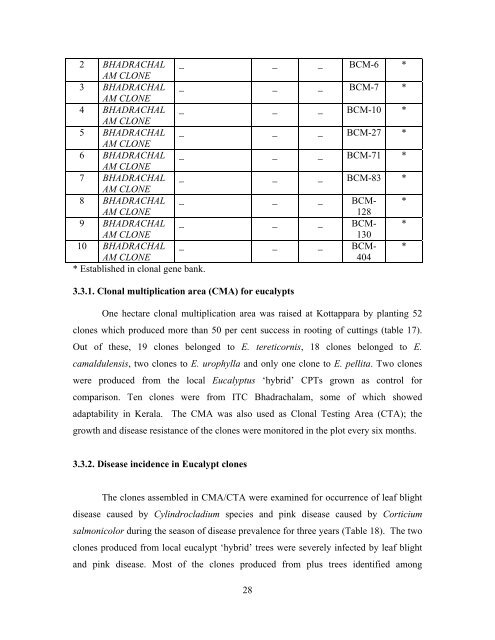2 BHADRACHAL _ _ _ BCM-6 *AM CLONE3 BHADRACHAL _ _ _ BCM-7 *AM CLONE4 BHADRACHAL _ _ _ BCM-10 *AM CLONE5 BHADRACHAL _ _ _ BCM-27 *AM CLONE6 BHADRACHAL _ _ _ BCM-71 *AM CLONE7 BHADRACHAL _ _ _ BCM-83 *AM CLONE8 BHADRACHAL _ _ _ BCM- *AM CLONE1289 BHADRACHAL _ _ _ BCM- *AM CLONE13010 BHADRACHAL _ _ _ BCM- *AM CLONE404* Established in clonal gene bank.3.3.1. Clonal multiplication area (CMA) for eucalyptsOne hectare clonal multiplication area was raised at Kottappara by planting 52clones which produced more than 50 per cent success in rooting of cuttings (table 17).Out of these, 19 clones belonged to E. tereticornis, 18 clones belonged to E.camaldulensis, two clones to E. urophylla and only one clone to E. pellita. Two cloneswere produced from the local Eucalyptus ‘hybrid’ CPTs grown as control forcomparison. Ten clones were from ITC Bhadrachalam, some of which showedadaptability in <strong>Kerala</strong>. The CMA was also used as Clonal Testing Area (CTA); thegrowth and disease resistance of the clones were monitored in the plot every six months.3.3.2. Disease incidence in Eucalypt clonesThe clones assembled in CMA/CTA were examined for occurrence of leaf blightdisease caused by Cylindrocladium species and pink disease caused by Corticiumsalmonicolor during the season of disease prevalence for three years (Table 18). The twoclones produced from local eucalypt ‘hybrid’ trees were severely infected by leaf blightand pink disease. Most of the clones produced from plus trees identified among28
provenances were free from infection or suffered low infection. Clones which showedfast growth and disease tolerance/resistance consistently for three years were selected andsupplied to the Central Nurseries of <strong>Kerala</strong> <strong>Forest</strong> Department and HNL for establishingtheir CMA for further mass multiplication (Figs. 9-13), and for raising plantations(Fig.14). Out of 42 <strong>KFRI</strong> clones tested in CMA/CTA, 20 clones were finally selected forthis purpose. These clones are listed in Table 19 and their potential yield is provided. Theproductivity potential is very high (10 - >40 m 3 ha -1 yr -1 ) and higher than that of theseedling crop of the best provenances. During 1998-2003, about 1.33 lakh ramets(seedlings) have been supplied to <strong>Kerala</strong> <strong>Forest</strong> Department alone (Table 20).Table 17. List of eucalypts clones planted in Clonal Multiplication Area (CMA) atKottapparaSl. <strong>No</strong>. Clone <strong>No</strong>. Provenance Name/SourceSeed lot<strong>No</strong>.E. tereticornis1 <strong>KFRI</strong> 14 Kennedy River, Qld 1 148022 <strong>KFRI</strong> 15 Morehead River, Qld 134443 <strong>KFRI</strong> 16 Morehead River, Qld 134444 <strong>KFRI</strong> 20 Kennedy Ck Pen Dev Rd, Qld 158275 <strong>KFRI</strong> 21 Kennedy Ck Pen Dev Rd, Qld 158276 <strong>KFRI</strong> 28 80 Km NNW Cook town, Qld 151987 <strong>KFRI</strong> 33 80 Km NNW Cook town, Qld 151988 <strong>KFRI</strong> 43 Ravenshoe, Qld 144249 <strong>KFRI</strong> 44 Morehead River, Qld 1344410 <strong>KFRI</strong> 49 Kennedy River, Qld 1 1480211 <strong>KFRI</strong> 50 Kennedy River, Qld 1 1480212 <strong>KFRI</strong> 56 Ravenshoe, Qld 1442413 <strong>KFRI</strong> 57 Sirinumu Sogeri Plat, Png 1442414 <strong>KFRI</strong> 58 Kennedy River, Qld 1 1480215 <strong>KFRI</strong> 60 Oro Bay to Emo, Png 1339916 <strong>KFRI</strong> 62 Kennedy River, Qld 1 1480217 <strong>KFRI</strong> 65 Kennedy Creek Pen Dev Road, Qld 1582718 <strong>KFRI</strong> 67 Oro Bay to Emo, Png 1339919 <strong>KFRI</strong> 71 R’ Hampton Race Course, Qld 13547E. camaldulenis20 <strong>KFRI</strong> 8 Katherine, NT 1380121 <strong>KFRI</strong>10 Cape River, Qld 1381522 <strong>KFRI</strong> 22 W. of Irvine Bank, Qld 1523423 <strong>KFRI</strong> 23 W. of <strong>No</strong>rmanton 1369529
















